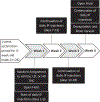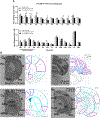Chronic Δ9-tetrahydrocannabinol treatment has dose-dependent effects on open field exploratory behavior and [3H] SR141716A receptor binding in the rat brain
- PMID: 37270168
- PMCID: PMC12006982
- DOI: 10.1016/j.lfs.2023.121825
Chronic Δ9-tetrahydrocannabinol treatment has dose-dependent effects on open field exploratory behavior and [3H] SR141716A receptor binding in the rat brain
Abstract
Aims: Acute and chronic Δ9-THC exposure paradigms affect the body differently. More must be known about the impact of chronic Δ9-THC on cannabinoid-1 (CB1R) and mu-opioid (MOR) receptor levels in the brain. The present study examined chronic Δ9-THC's effects on CB1R and MOR levels and locomotor activity.
Main methods: Adolescent Sprague-Dawley rats were given daily intraperitoneal injections of Δ9-THC [0.75mg/kg (low dose or LD) or 2.0 mg/kg (high dose or HD)] or vehicle for 24 days, and locomotion in the open field was tested after the first and fourth weeks of chronic Δ9-THC exposure. Brains were harvested at the end of treatment. [3H] SR141716A and [3H] DAMGO autoradiography assessed CB1R and MOR levels, respectively.
Key findings: Relative to each other, chronic HD rats showed reduced vertical plane (VP) entries and time, while LD rats had increased VP entries and time for locomotion, as assessed by open-field testing; no effects were found relative to the control. Autoradiography analyses showed that HD Δ9-THC significantly decreased CB1R binding relative to LD Δ9-THC in the cingulate (33%), primary motor (42%), secondary motor (33%) somatosensory (38%), rhinal (38%), and auditory (50%) cortices; LD Δ9-THC rats displayed elevated binding in the primary motor (33% increase) and hypothalamic (33% increase) regions compared with controls. No significant differences were observed in MOR binding for the LD or HD compared to the control.
Significance: These results demonstrate that chronic Δ9-THC dose-dependently altered CB1R levels throughout the brain and locomotor activity in the open field.
Keywords: Addiction; Autoradiography; CB1; Cannabis; Mu-opioid; Δ9-Tetrahydrocannabinol.
Copyright © 2023 Elsevier Inc. All rights reserved.
Conflict of interest statement
Declaration of competing interest The authors declare that they have no known competing financial interests or personal relationships that could have appeared to influence the work reported in this paper.
Figures




References
-
- SAMHSA, Key Substance Use and Mental Health Indicators in the United States: Results From the 2019 National Survey on Drug Use and Health, Substance Abuse and Mental Health Services Administration, 2020. - PubMed
-
- Chiu V, et al., Public health impacts to date of the legalisation of medical and recreational cannabis use in the USA, Neuropharmacology 193 (2021), 108610. - PubMed
MeSH terms
Substances
Grants and funding
LinkOut - more resources
Full Text Sources
Research Materials

